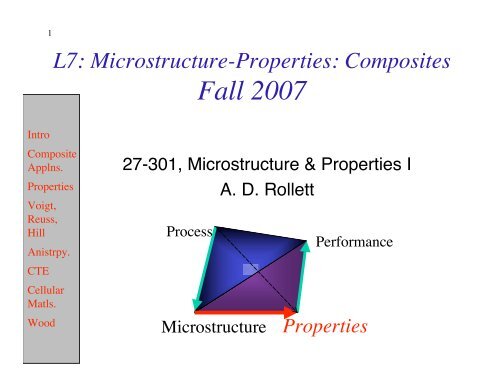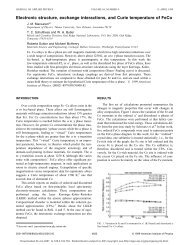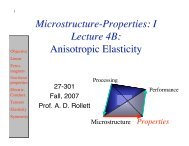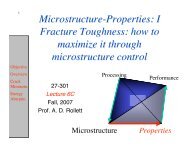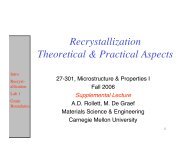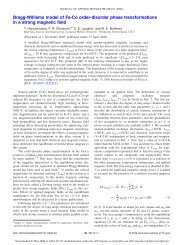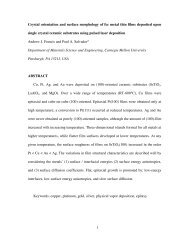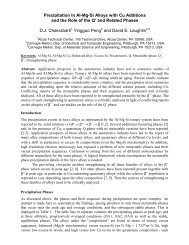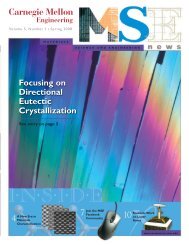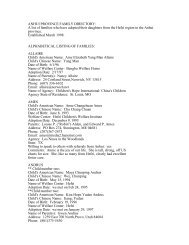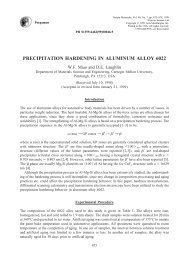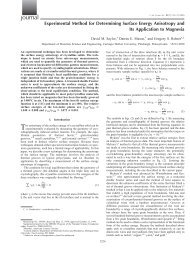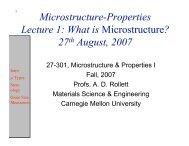L7 composites - Materials Science and Engineering
L7 composites - Materials Science and Engineering
L7 composites - Materials Science and Engineering
Create successful ePaper yourself
Turn your PDF publications into a flip-book with our unique Google optimized e-Paper software.
Intro<br />
1<br />
Composite<br />
Applns.<br />
Properties<br />
Voigt,<br />
Reuss,<br />
Hill<br />
Anistrpy.<br />
CTE<br />
Cellular<br />
Matls.<br />
Wood<br />
<strong>L7</strong>: Microstructure-Properties: Composites<br />
Fall 2007<br />
27-301, Microstructure & Properties I<br />
Processing<br />
A. D. Rollett<br />
Performance<br />
Microstructure Properties
Intro<br />
2<br />
Composite<br />
Applns.<br />
Properties<br />
Voigt,<br />
Reuss,<br />
Hill<br />
Anistrpy.<br />
CTE<br />
Cellular<br />
Matls.<br />
Wood<br />
Lecture Objectives: Composites<br />
• The main objective of this lecture is to introduce you<br />
to microstructure-property relationships in composite<br />
materials.<br />
• Composite materials constitute a huge class of<br />
materials. The objective of this lecture will therefore<br />
be to provide some definitions <strong>and</strong> describe some of<br />
the basic relationships.<br />
• Cellular materials will be emphasized because of<br />
their connection to natural materials (biomaterials)<br />
<strong>and</strong> especially wood, which you will study in the<br />
second Lab.
Intro<br />
3<br />
Composite<br />
Applns.<br />
Properties<br />
Voigt,<br />
Reuss,<br />
Hill<br />
Anistrpy.<br />
CTE<br />
Cellular<br />
Matls.<br />
Wood<br />
Key points<br />
• Composites are regarded as artificial (man-made)<br />
mixtures of phases.<br />
• Classification of <strong>composites</strong> by reinforcement type<br />
(dimensionality) - particles, fibers <strong>and</strong> laminated.<br />
• Application of the Rule of Mixtures.<br />
• Dependence of composite properties on the spatial<br />
arrangement of the phases.<br />
• Upper <strong>and</strong> lower bounds on properties - example of<br />
elastic modulus, Voigt <strong>and</strong> Reuss approximations.<br />
• Anisotropy of composite properties, e.g. elastic<br />
modulus.<br />
• Properties of wood as a cellular material.
Intro<br />
4<br />
Composite<br />
Applns.<br />
Properties<br />
Voigt,<br />
Reuss,<br />
Hill<br />
Anistrpy.<br />
CTE<br />
Cellular<br />
Matls.<br />
Wood<br />
Examples
Intro<br />
5<br />
Composite<br />
Applns.<br />
Properties<br />
Voigt,<br />
Reuss,<br />
Hill<br />
Anistrpy.<br />
CTE<br />
Cellular<br />
Matls.<br />
Wood<br />
What are Composites?<br />
• Composite materials contain more than one phase.<br />
• Almost all materials contain more than one phase, so<br />
what’s the difference?<br />
• The term composite is typically applied to a material<br />
when the multi-phase structure is constructed by<br />
direct intervention (external to the material).<br />
• Composite Material Examples: glass fiber reinforced<br />
plastic (GRP), wood, clam shell, Mars bar.<br />
• Multi-phase Material Examples: precipitation<br />
strengthened aluminum alloys, Ti-6Al-4V, dual-phase<br />
steel, transformation toughened alumina (Al 2 O 3 -<br />
CeO 2 ).<br />
• Caution! There is some overlap between the<br />
categories!
Intro<br />
6<br />
Why Use Composites? [Biomaterials]<br />
Composite<br />
Applns.<br />
Properties<br />
Voigt,<br />
Reuss,<br />
Hill<br />
Anistrpy.<br />
CTE<br />
Cellular<br />
Matls.<br />
Wood<br />
• In nature, the basic materials tend to be weak <strong>and</strong>/or brittle.<br />
Evolution has resulted in structures that combine materials<br />
together for properties that far exceed those that could be<br />
obtained in the basic materials.<br />
• The basic inorganic constituent of bone, for example, is calcium<br />
phosphate in the form of crystalline Ca 10 (PO 4 ) 6 (OH) <strong>and</strong><br />
amorphous CaPO 3 . This ceramic is brittle <strong>and</strong> not particularly<br />
stiff. The matrix of fibrous collagen is tough but even less stiff.<br />
When embedded arranged in the form of a cellular material,<br />
however, remarkable values of stiffness:density <strong>and</strong><br />
toughness:density are achieved [<strong>and</strong> l<strong>and</strong>-based multi-tonne<br />
creatures are possible].<br />
• A similar situation exists in wood where the basic materials are<br />
quite compliant but arranged in the multi-level composite forms<br />
that we know, high values of strength:density <strong>and</strong><br />
toughness:density result.
Intro<br />
7<br />
Composite<br />
Applns.<br />
Properties<br />
Voigt,<br />
Reuss,<br />
Hill<br />
Anistrpy.<br />
CTE<br />
Cellular<br />
Matls.<br />
Wood<br />
Why Use Composites? [Man-made]<br />
• The basic reason for the use of <strong>composites</strong> is always<br />
the same: some combination of properties can be<br />
achieved that is impossible in a monolithic material<br />
[for a given cost].<br />
• In SiC-reinforced aluminum for brake rotors, for<br />
example, the combination of light weight, toughness<br />
(from the Al matrix at ~ 2.7 Mgm/m 3 ), <strong>and</strong> stiffness<br />
(from the SiC additions) is not possible in either<br />
constituent by itself.<br />
• In Cu-Nb for high strength electrical conductors, the<br />
combination of >1GPa yield strength <strong>and</strong> high<br />
electrical conductivity (in the Cu) could never be<br />
achieved in either constituent by itself. In this case<br />
the high strength is a synergistic property of the<br />
composite.
Intro<br />
8<br />
Composite<br />
Applns.<br />
Properties<br />
Voigt,<br />
Reuss,<br />
Hill<br />
Anistrpy.<br />
CTE<br />
Cellular<br />
Matls.<br />
Wood<br />
Key aspects of <strong>composites</strong><br />
• Composites are expensive to make, as<br />
compared to monolithic materials, especially<br />
if the shape <strong>and</strong> arrangement of the phases<br />
must be controlled.<br />
• Therefore there must be a strong motivation<br />
for making a composite structure to offset<br />
the cost.<br />
• The simplest <strong>composites</strong> are particulate<br />
<strong>composites</strong>. Laminates are next, followed<br />
by fiber <strong>composites</strong>. Woven structures are<br />
the most complex.
Intro<br />
9<br />
Composite<br />
Applns.<br />
Properties<br />
Voigt,<br />
Reuss,<br />
Hill<br />
Anistrpy.<br />
CTE<br />
Cellular<br />
Matls.<br />
Wood<br />
Typical Microstructures<br />
• We show next some typical microstructures.<br />
• In biomaterials, many are cellular <strong>composites</strong><br />
at some length scale.<br />
• Man-made <strong>composites</strong> are more often fully<br />
dense. The three major [structural] material<br />
types are all used so the abbreviations MMC<br />
[metal matrix composite], CMC [ceramic<br />
matrix composite], <strong>and</strong> PMC [polymer matrix<br />
composite] are commonly used.
10<br />
Intro<br />
Composite<br />
Applns.<br />
Properties<br />
Voigt,<br />
Reuss,<br />
Hill<br />
Anistrpy.<br />
CTE<br />
Cellular<br />
Matls.<br />
Wood<br />
Cellular<br />
Biomaterials<br />
Note the<br />
variation in<br />
density; also the<br />
presence of<br />
distinct layers of<br />
cells in some<br />
woods, <strong>and</strong> in<br />
bone.<br />
Gibson: Cellular<br />
Solids
11<br />
Intro<br />
Composite<br />
Applns.<br />
Properties<br />
Voigt,<br />
Reuss,<br />
Hill<br />
Anistrpy.<br />
CTE<br />
Cellular<br />
Matls.<br />
Wood<br />
Man-made Examples<br />
Note the typical length<br />
scale of ~100µm, <strong>and</strong><br />
the use of fibers for<br />
reinforcement. This<br />
basic type of fiberreinforced<br />
composite<br />
is strongly anisotropic.<br />
The toughness of such<br />
<strong>composites</strong> <strong>and</strong> the<br />
need for limited<br />
adhesion between<br />
fiber <strong>and</strong> matrix was<br />
discussed in the<br />
lecture on Fracture.<br />
Dowling: Mech. Beh.<br />
Matls.<br />
SiC fibers in Ti 3 Al matrix<br />
SiC fibers in a CAS ceramic matrix
12<br />
Intro<br />
Composite<br />
Applns.<br />
Properties<br />
Voigt,<br />
Reuss,<br />
Hill<br />
Anistrpy.<br />
CTE<br />
Cellular<br />
Matls.<br />
Wood<br />
Food!<br />
From left to right,<br />
top to bottom:<br />
a) Bread<br />
b) Meringue<br />
c) Chocolate bar<br />
d) Chip<br />
e) Malteser<br />
(C<strong>and</strong>y)<br />
f) Jaffa cake<br />
(cookie)
13<br />
Intro<br />
Composite<br />
Applns.<br />
Properties<br />
Voigt,<br />
Reuss,<br />
Hill<br />
Anistrpy.<br />
CTE<br />
Cellular<br />
Matls.<br />
Wood<br />
Food for Thought!<br />
• How does ice cream represent a material in<br />
which the thermal-mechanical history is<br />
critical to its microstructure which, in turn,<br />
controls its properties? Homework!
14<br />
Intro<br />
Composite<br />
Applns.<br />
Properties<br />
Voigt,<br />
Reuss,<br />
Hill<br />
Anistrpy.<br />
CTE<br />
Cellular<br />
Matls.<br />
Wood<br />
Examples of <strong>composites</strong><br />
• The classical example of a composite is concrete.<br />
• It is more complex than it appears. There are<br />
typically coarse <strong>and</strong> fine particles (rocks!) embedded<br />
in a matrix of silicates <strong>and</strong> sulfates. There is a high<br />
fraction of pores of all sizes. This is an example of a<br />
particulate composite.<br />
• Ordinary concrete (properly made) has excellent<br />
compressive strength but poor tensile strength. Thus<br />
reinforced concrete was invented to combine the<br />
tensile strength of steel with the compressive<br />
strength of concrete. This is an example of a<br />
multiscale particulate <strong>and</strong> fiber reinforced composite.<br />
It is particulate because the aggregate (coarse<br />
gravel) reinforces the cement, <strong>and</strong> fiber because the<br />
steel rods reinforce the concrete.
15<br />
Intro<br />
Composite<br />
Applns.<br />
Properties<br />
Voigt,<br />
Reuss,<br />
Hill<br />
Anistrpy.<br />
CTE<br />
Cellular<br />
Matls.<br />
Wood<br />
Glass-ceramics<br />
• Glass ceramics are useful materials that combine<br />
chemical inertness with thermal stability. They<br />
typically are stronger than amorphous glasses.<br />
• This composition was invented (S<strong>and</strong>ia) for the<br />
specific purpose of making a material (insulator) that<br />
would have a good match for the thermal expansion<br />
characteristics of metals (stainless steel, nickel<br />
alloys), i.e. a relatively high CTE.<br />
• Typical phase mixture includes lithium silicate(s),<br />
cristobalite <strong>and</strong> residual glass phase.
16<br />
Intro<br />
Composite<br />
Applns.<br />
Properties<br />
Voigt,<br />
Reuss,<br />
Hill<br />
Anistrpy.<br />
CTE<br />
Cellular<br />
Matls.<br />
Wood<br />
Properties<br />
• It is useful to review the basic properties of the<br />
different types of materials that are used in<br />
<strong>composites</strong>.<br />
• Polymers - long [carbon] chain molecules with<br />
anything from van der Waals bonding between the<br />
chains (thermoplastics) to covalent links<br />
(thermosets). Low density, low modulus compared to<br />
other materials. Often highly formable (ductile).<br />
• Ceramics - ionic or covalent bonding, lower symmetry<br />
crystal structures, high melting point <strong>and</strong> modulus,<br />
resistant to degradation, brittle, high modulus.<br />
• Metals - metallic bonding, symmetric crystal<br />
structures, medium melting point, medium modulus,<br />
ductile, formable, variable resistance to degradation.
17<br />
Intro<br />
Composite<br />
Applns.<br />
Properties<br />
Voigt,<br />
Reuss,<br />
Hill<br />
Anistrpy.<br />
CTE<br />
Cellular<br />
Matls.<br />
Wood<br />
Property Ranges<br />
A much wider range of<br />
properties is possible in<br />
<strong>composites</strong> than in<br />
monolithic materials.<br />
Foams permit much<br />
smaller moduli <strong>and</strong><br />
densities than fully dense<br />
materials. The following<br />
chart illustrates a few<br />
basic properties.<br />
Gibson: Cellular<br />
Solids
18<br />
Intro<br />
Composite<br />
Applns.<br />
Properties<br />
Voigt,<br />
Reuss,<br />
Hill<br />
Anistrpy.<br />
CTE<br />
Cellular<br />
Matls.<br />
Wood<br />
Notation<br />
A, B, C phases A <strong>and</strong> B, Composite<br />
VA volume fraction of phase A<br />
PA property of phase A<br />
EA (Young’s) modulus of phase A<br />
εC (average) strain in composite<br />
σA stress in phase A<br />
K bulk modulus<br />
G shear modulus<br />
α coefficient of thermal expansion (CTE)<br />
ρs, ρcell cell wall density<br />
ρ* relative density (cellular material)<br />
l length (of a beam)<br />
t thickness<br />
b depth<br />
δ displacement<br />
KIC fracture toughness [plane strain]<br />
P load
19<br />
Intro<br />
Composite<br />
Applns.<br />
Properties<br />
Voigt,<br />
Reuss,<br />
Hill<br />
Anistrpy.<br />
CTE<br />
Cellular<br />
Matls.<br />
Wood<br />
Simple Models: Rule of Mixtures<br />
• What is the simplest model that can be used to<br />
predict a material property in a composite?<br />
Answer: Rule of Mixtures<br />
• Define the volume fractions, V, of the various<br />
materials comprising the composite. The average<br />
property of the composite is then given by,<br />
P C = V A P A + V B P B + … = Σ V i P i<br />
• The Rule of Mixtures is an acceptable first<br />
approximation for estimating composite material<br />
properties. It is, however, often considerably in error<br />
<strong>and</strong> better methods are required.
20<br />
Intro<br />
Composite<br />
Applns.<br />
Properties<br />
Voigt,<br />
Reuss,<br />
Hill<br />
Anistrpy.<br />
CTE<br />
Cellular<br />
Matls.<br />
Wood<br />
Limits, bounds<br />
• There are some circumstances under which one<br />
would like to be able to make quantitative<br />
predictions of the properties of a composite but an<br />
exact solution is not available.<br />
• Under these circumstances, it is still possible to set<br />
limits on the property. In a formal sense these<br />
limits are known as bounds because they are the<br />
result of analysis using the principles of solid<br />
mechanics. Such analysis can demonstrate that an<br />
either an upper or a lower (or both) bound exists for<br />
a given structure <strong>and</strong> loading.<br />
• An upper bound means that the value of the<br />
property cannot go any higher than a certain value<br />
<strong>and</strong> vice versa for a lower bound.
21<br />
Intro<br />
Composite<br />
Applns.<br />
Properties<br />
Voigt,<br />
Reuss,<br />
Hill<br />
Anistrpy.<br />
CTE<br />
Cellular<br />
Matls.<br />
Wood<br />
Exact versus bounds<br />
• Exact solutions are usually available for simple<br />
geometries. Reinforced concrete with parallel rods<br />
is such an example.<br />
• Complex geometries are almost always limited to<br />
approximate solutions <strong>and</strong> bounds provide the best<br />
estimate. Most particulate <strong>composites</strong>, especially<br />
those with cracks fall in this category.<br />
• The most interesting properties for this lecture are<br />
those associated with mechanical behavior such as<br />
stiffness, strength, thermal expansion.<br />
• In the most general sense, we are seeking methods<br />
for averaging a property over the heterogeneous<br />
elements of the microstructure.
22<br />
Intro<br />
Composite<br />
Applns.<br />
Properties<br />
Voigt,<br />
Reuss,<br />
Hill<br />
Anistrpy.<br />
CTE<br />
Cellular<br />
Matls.<br />
Wood<br />
Isostress, isostrain<br />
• “Iso-” is a prefix meaning “same”. Isostress<br />
is an assumption that the phases<br />
experience the same stress. By contrast,<br />
isostrain makes the assumption that the<br />
phases are subject to the same strain.<br />
• Each assumption leads to very different<br />
results, especially when the properties of<br />
each phase are divergent, as we see from<br />
the example of the brick <strong>and</strong> the foam.
23<br />
Intro<br />
Composite<br />
Applns.<br />
Properties<br />
Voigt,<br />
Reuss,<br />
Hill<br />
Anistrpy.<br />
CTE<br />
Cellular<br />
Matls.<br />
Wood<br />
Isostrain<br />
• Imagine parallel slabs of<br />
material between platens that<br />
apply a load.<br />
• Phase A has volume fraction<br />
V A <strong>and</strong> modulus E A ; Phase B<br />
has volume fraction V B <strong>and</strong><br />
modulus E B .<br />
• Composite modulus, E C ?<br />
• We assume isostrain because<br />
each phase sees the same<br />
change in length.<br />
• The strain, ε= ε C , is therefore<br />
the field; the stress is the<br />
response (<strong>and</strong> the stiffness is<br />
the property).<br />
Phase A<br />
Phase B
24<br />
Intro<br />
Composite<br />
Applns.<br />
Properties<br />
Voigt,<br />
Reuss,<br />
Hill<br />
Anistrpy.<br />
CTE<br />
Cellular<br />
Matls.<br />
Wood<br />
Isostrain: 2<br />
• Each phase gives a different stress:<br />
σ A =E A ε C ; σ B =E B ε C .<br />
• We average the stresses over the<br />
composite in proportion to the volume<br />
fraction of the phase:<br />
σ C =V Aσ A + V Bσ B = V A E A ε C + V B E B ε C .<br />
• The modulus is the ratio of the stress to<br />
the strain in the composite:<br />
E C = σ C / ε C = V A E A + V B E B<br />
• This modulus is thus the arithmetic<br />
mean of the moduli of each phase,<br />
weighted by the volume fractions. In<br />
effect, the rule of mixtures has been<br />
applied to the stiffnesses.<br />
• Exercise: prove to yourself that this can<br />
be extended to any number of phases.<br />
Phase A<br />
Phase B
25<br />
Intro<br />
Composite<br />
Applns.<br />
Properties<br />
Voigt,<br />
Reuss,<br />
Hill<br />
Anistrpy.<br />
CTE<br />
Cellular<br />
Matls.<br />
Wood<br />
Isostress<br />
• Imagine parallel slabs of<br />
material between platens that<br />
apply a load.<br />
• Phase A has volume fraction<br />
V A <strong>and</strong> modulus E A ; Phase B<br />
has volume fraction V B <strong>and</strong><br />
modulus E B .<br />
• Composite modulus, E C ?<br />
• We assume isostress because<br />
each phase sees the same<br />
stress (assuming same crosssectional<br />
area).<br />
• The stress, σ = σ C , is therefore<br />
the field; the strain is the<br />
response (<strong>and</strong> the compliance<br />
is the property).<br />
Phase A<br />
Phase B
26<br />
Intro<br />
Composite<br />
Applns.<br />
Properties<br />
Voigt,<br />
Reuss,<br />
Hill<br />
Anistrpy.<br />
CTE<br />
Cellular<br />
Matls.<br />
Wood<br />
Isostress: 2<br />
• Each phase gives a different strain:<br />
ε A = σ C /E A ; ε B = σ C /E B .<br />
• We average the strains over the<br />
composite in proportion to the volume<br />
fraction of the phase:<br />
ε C =V A ε A + V B ε B = V Aσ C /E A + V Bσ C /E B .<br />
• The modulus of the composite is the<br />
ratio of the stress to the strain in the<br />
composite as before, except that it is<br />
easier to work with inverse moduli, i.e.<br />
compliances:<br />
1/E C = ε C/σ C = V A /E A + V B /E B<br />
• The composite modulus is thus the<br />
harmonic mean of the moduli of each<br />
phase, weighted by the volume<br />
fractions. In effect, the rule of mixtures<br />
has been applied to the compliances.<br />
Phase A<br />
Phase B
27<br />
Intro<br />
Composite<br />
Applns.<br />
Properties<br />
Voigt,<br />
Reuss,<br />
Hill<br />
Anistrpy.<br />
CTE<br />
Cellular<br />
Matls.<br />
Wood<br />
Example of Cu-W<br />
Composites<br />
• The graphs show (a) examples of<br />
the difference in the calculated<br />
modulus based on the 2 different<br />
assumptions [parallel is equivalent<br />
to isostrain, <strong>and</strong> series to isostress];<br />
(b) an example of the measured<br />
difference in modulus of Cu-W<br />
<strong>composites</strong>, contrasting wire [=fiber]<br />
with particle reinforcement. The<br />
fiber composite corresponds very<br />
closely to the isostrain estimate; the<br />
particulate composite is close to the<br />
isostress, although not quite so<br />
precisely.<br />
• Note how the isostress <strong>and</strong> isostrain<br />
estimates are similar when the<br />
moduli differ by only a factor of two.<br />
When the moduli differ by an order<br />
of magnitude, however, the two<br />
estimates differ widely.<br />
“Structural <strong>Materials</strong>”, Weidemann, Lewis <strong>and</strong> Reid
28<br />
Intro<br />
Composite<br />
Applns.<br />
Properties<br />
Voigt,<br />
Reuss,<br />
Hill<br />
Anistrpy.<br />
CTE<br />
Cellular<br />
Matls.<br />
Wood<br />
Voigt, Reuss, Hill<br />
• These simple estimates of modulus have names associated<br />
with them.<br />
• The isostress approach is known as the Reuss modulus.<br />
• The isostrain approach is known as the Voigt modulus.<br />
• Hill proposed that a reasonable average of the two would be<br />
appropriate in materials where the loading is intermediate<br />
between the two extreme cases. Hence the average of the<br />
Isotress <strong>and</strong> Isostrain values is known as the Hill Average<br />
Modulus.<br />
• We can also treat the composite property (for elastic modulus)<br />
in terms of an arithmetic mean (isostrain) versus a harmonic<br />
mean (isostress), which is the reciprocal of the average of the<br />
reciprocal values.<br />
• Are there better estimates? Yes, look in the Supplemental<br />
slides for a description of the Hashin-Shtrikman estimates of<br />
modulus. There are also textbooks by Mura, Nemat-Nasser,<br />
Milton <strong>and</strong> several others.
29<br />
Intro<br />
Composite<br />
Applns.<br />
Properties<br />
Voigt,<br />
Reuss,<br />
Hill<br />
Anistrpy.<br />
CTE<br />
Cellular<br />
Matls.<br />
Wood<br />
Fiber Composites<br />
• An important class of <strong>composites</strong> is that of fiber <strong>composites</strong>.<br />
• The materials involved may be metal, ceramic or polymer. Glass-fiber<br />
composite is typical in low-cost structures such as boat hulls. Carbon-fiber<br />
<strong>composites</strong> are used in higher performance structures such as airplanes where<br />
their higher cost is justified by the requirements. Ceramic <strong>composites</strong> are used<br />
typically for high temperature service, such as heat exchangers.<br />
• The basic idea is to take advantage of high strength <strong>and</strong> stiffness of the fibers<br />
<strong>and</strong> to obtain damage tolerance (<strong>and</strong> specific shapes) by embedding them in a<br />
suitable matrix. More specifically, the fiber material (e.g. graphite, glass) is a<br />
material that would not generally be considered to be a structural material.<br />
• Solid mechanics of fiber <strong>composites</strong>: the key to underst<strong>and</strong>ing the mechanical<br />
properties of fiber <strong>composites</strong> (for fibers whose length is short compared to the<br />
size of the component) is load transfer between the matrix <strong>and</strong> the fibers. This<br />
means that the stress on each fiber varies along its length. Also, the composite<br />
materials are strongly anisotropic (so tensors are useful again). See discussion<br />
in the supplemental slides.<br />
• Modern developments: carbon nanotubes offer exceptional stiffness <strong>and</strong><br />
strength, not to mention interesting electrical properties in some cases. If we<br />
can figure out how to separate out the various different conformations <strong>and</strong> how<br />
to align the nanotubes, there should be a wide range of exciting materials<br />
possible.
30<br />
Fibers for Polymer Matrix Composites<br />
Intro<br />
Composite<br />
Applns.<br />
Properties<br />
Voigt,<br />
Reuss,<br />
Hill<br />
Anistrpy.<br />
CTE<br />
Cellular<br />
Matls.<br />
Wood<br />
• Many types of fibers are available: carbon,<br />
glass, aramid, quartz, polyethylene, boron,<br />
silicon carbide, alumina, aluminosilicate.<br />
• The polymer matrix<br />
composite business is<br />
dominated by volume<br />
by carbon, glass <strong>and</strong><br />
aramid fibers because<br />
they offer the best<br />
performance:price<br />
ratio.<br />
“Mechanics of Fibrous Composites”, C.T. Herakovich
31<br />
Intro<br />
Composite<br />
Applns.<br />
Properties<br />
Voigt,<br />
Reuss,<br />
Hill<br />
Anistrpy.<br />
CTE<br />
Cellular<br />
Matls.<br />
Wood<br />
Carbon Fibers<br />
• Modulus ranges from 200-750 GPa (cf. Steel-210)<br />
• Strength ranges from 2-6 GPa<br />
• Breaking strain ranges from 0.2 - 2 %<br />
• Density ranges from 1.76- 2.15<br />
• Highest cost compared to glass or aramid, but<br />
greatest range of properties.<br />
• Internal structure consists of radially-aligned graphite<br />
platelets, which leads to some anisotropy in<br />
properties in the fibers. Both thermal <strong>and</strong> electrical<br />
conductivity are generally good (but then insulation<br />
required where metals might be in contact for carbonfiber<br />
composite).
32<br />
Intro<br />
Composite<br />
Applns.<br />
Properties<br />
Voigt,<br />
Reuss,<br />
Hill<br />
Anistrpy.<br />
CTE<br />
Cellular<br />
Matls.<br />
Wood<br />
Glass Fibers<br />
• Glass fibers produced by spinning liquid glass directly<br />
to fine fibers. Just as in the Griffith experiments, the<br />
strength is based on small diameter.<br />
• Modulus ranges from 70- 90 GPa.<br />
• Strength ranges from 1.7-5 GPa<br />
• Breaking strain from 2 to 5%<br />
• Density ~ 2.5 gm/cc.<br />
• “E glass” [electrical, borosilicate glass] is the<br />
cheapest <strong>and</strong> most common. “R glass” <strong>and</strong> “S glass”<br />
is more expensive but more corrosion resistant, for<br />
example <strong>and</strong> higher strength.
33<br />
Intro<br />
Composite<br />
Applns.<br />
Properties<br />
Voigt,<br />
Reuss,<br />
Hill<br />
Anistrpy.<br />
CTE<br />
Cellular<br />
Matls.<br />
Wood<br />
Aramid Fibers<br />
• Aramid fibers are produced by drawing liquid crystal<br />
polymers based on, e.g. polyparabenzamide or<br />
polyparaphenylene terephthalamide.<br />
• Polymer chains arranged in radially oriented, kinked<br />
sheets. Bonding between the molecules is largely<br />
hydrogen bonding so the transverse properties are<br />
weak compared to on-axis. Therefore difficult to<br />
propagate a crack along a fiber.<br />
• Modulus ranges from 55-120 GPa<br />
• Strength ranges from 3 to 3.6 GPa<br />
• Breaking strain ranges from 2.5 to 4%<br />
• Density ~ 1.45 gm/cc.<br />
• Aramid fibers vulnerable to environmental<br />
degradation (sunlight).
34<br />
Intro<br />
Composite<br />
Applns.<br />
Properties<br />
Voigt,<br />
Reuss,<br />
Hill<br />
Anistrpy.<br />
CTE<br />
Cellular<br />
Matls.<br />
Wood<br />
Residual Stresses <strong>and</strong> Composites<br />
• In a stationary body that is free of external loads, the average stress (<strong>and</strong><br />
moment) must be zero because (Newton’s Laws) there must be no net force on<br />
it.<br />
• The stress state inside the body, however, can vary arbitrarily. Such variable<br />
internal stresses are often know as residual stresses because they are the leftover<br />
from previous processing.<br />
• The simplicity of elastic stresses is that they can be superimposed. Therefore<br />
one can assume in beam loading that the stresses imposed by external loading<br />
can be added to the internal variations.<br />
• As with all phenomena, there are engineering applications. Reinforced<br />
concrete, for example, is a fiber-reinforced composite with a brittle matrix<br />
(concrete) <strong>and</strong> a ductile fiber reinforcement (steel bars or cable). The steel is<br />
typically held in tension during the setting-up of the concrete, resulting in a<br />
composite for which the steel is in a state of tension <strong>and</strong> the concrete is in<br />
compression.<br />
• For fiber-reinforced materials, for example, a difference in thermal expansion<br />
coefficient can produce a residual stress state in a composite. For example, if<br />
the fiber has a smaller CTE <strong>and</strong> the composite is cooled from a zero stress state<br />
at high temperature, then the matrix shrinks more than the reinforcing fibers,<br />
putting the matrix in tension <strong>and</strong> the fibers in compression.
35<br />
Intro<br />
Composite<br />
Applns.<br />
Properties<br />
Voigt,<br />
Reuss,<br />
Hill<br />
Anistrpy.<br />
CTE<br />
Cellular<br />
Matls.<br />
Wood<br />
Reinforced Concrete<br />
• Steps required:<br />
1. Stretch reinforcing steel cables (i.e. place them in tension)<br />
2. Pour concrete around the cables; allow concrete to set<br />
3. Remove tensioning force from steel cables<br />
4. The steel cables contract elastically but the concrete matrix resists the<br />
contraction<br />
5. Steel remains in tension (did not shrink back to zero strain) whereas the<br />
concrete is in compression to balance the tensile stress in the steel<br />
cables<br />
• Question: is there an optimum location for the reinforcement within<br />
the beam? At the top? Bottom?<br />
• Loading of Reinforced Concrete Beams:<br />
– As the beam is loaded (e.g. 3-point bending), the concrete underneath<br />
the loading point experiences the sum of its residual compressive<br />
stress, plus the tensile stress from the bending load. For moderate<br />
loads, the stress remains compressive, protecting against brittle failure.<br />
• Famous example (local to Pittsburgh): the cantilevered terraces of<br />
Frank Lloyd Wright’s house, Fallingwater.<br />
• http://structsource.com/analysis/types/concrete.htm
36<br />
Intro<br />
Composite<br />
Applns.<br />
Properties<br />
Voigt,<br />
Reuss,<br />
Hill<br />
Anistrpy.<br />
CTE<br />
Cellular<br />
Matls.<br />
Wood<br />
Cellular <strong>Materials</strong><br />
• This next section provides some basic information on<br />
cellular materials.<br />
• Why study cellular materials? Answer: cellular<br />
materials provide a range of properties that are not<br />
achievable in bulk materials. Especially when load<br />
carrying capacity at very low densities is required,<br />
only cellular materials can satisfy the requirements.<br />
Shock resistance is also a vital characteristic of<br />
cellular materials.<br />
• Cellular structures are feasible (<strong>and</strong> used for<br />
engineering applications) with all materials types.<br />
Metal honeycombs are used in transport applications.<br />
Ceramic foams are used in insulation. Cellular<br />
structures are ubiquitous in biomaterials (wood, bone,<br />
shells…).
37<br />
Intro<br />
Composite<br />
Applns.<br />
Properties<br />
Voigt,<br />
Reuss,<br />
Hill<br />
Anistrpy.<br />
CTE<br />
Cellular<br />
Matls.<br />
Wood<br />
Honeycombs-<br />
properties<br />
• Note the contrast<br />
between tension <strong>and</strong><br />
compression<br />
(plateau present),<br />
4.2a vs. 4.2b.<br />
• Even brittle wall<br />
materials exhibit<br />
progressive failure in<br />
compression, 4.2e.<br />
• The stress-strain<br />
curves are labeled<br />
by their<br />
characteristic<br />
stages.<br />
[Gibson: Cellular <strong>Materials</strong>]
38<br />
Intro<br />
Composite<br />
Applns.<br />
Properties<br />
Voigt,<br />
Reuss,<br />
Hill<br />
Anistrpy.<br />
CTE<br />
Cellular<br />
Matls.<br />
Wood<br />
Wood<br />
It is important to underst<strong>and</strong><br />
wood as a cellular, composite<br />
structure. It is one, however,<br />
that has several different length<br />
scales from that of the cellulose<br />
molecule to the macrostructure<br />
of lumber as we accustomed to<br />
looking at it at the visual scale.<br />
The figure illustrates the<br />
hierarchy of length scales from<br />
the atomic structure of cellulose<br />
to the structure of a tree trunk.<br />
The basic building block of<br />
wood is the polymer of glucose<br />
known as cellulose, which<br />
occurs as a (mostly) crystalline<br />
fiber. The other critical<br />
component of wood is lignin,<br />
which is a complex, amorphous<br />
material containing phenyl<br />
groups. Lignin sets wood apart<br />
from other plants; its occurrence<br />
as outer <strong>and</strong> inner linings of the<br />
cell walls is critical for both<br />
structural properties <strong>and</strong> for<br />
wood’s (relative) insensitivity to<br />
environment.<br />
E<br />
D<br />
C<br />
F<br />
A B
39<br />
Intro<br />
Composite<br />
Applns.<br />
Properties<br />
Voigt,<br />
Reuss,<br />
Hill<br />
Anistrpy.<br />
CTE<br />
Cellular<br />
Matls.<br />
Wood<br />
Cellulose<br />
• Cellulose: a high molecular weight, stereoregular, <strong>and</strong> linear<br />
polymer of repeating beta-D-glucopyranose units. It is the main<br />
structural element <strong>and</strong> major constituent of the cell wall of trees<br />
<strong>and</strong> plants. The empirical formula for cellulose is (C 6 H 10 O 5 )n<br />
where 'n' is degree of polymerization (DP).<br />
[http://www.paperonweb.com/wood.htm]<br />
Substance Degree of Polymerization<br />
(DP)<br />
Molecular Weight<br />
Native Cellulose >3500 >570,000<br />
Purified Cotton 1000 - 3000 150,000 - 500,000<br />
Wood Pulp 600 - 1000 90,000 - 150,000<br />
Commercial Regenerated<br />
Cellulose (e.g. Rayon)<br />
200 - 600 30,000 - 150,000<br />
Cellulose 15 - 90 3000 - 15,000<br />
Y Cellulose
40<br />
Intro<br />
Composite<br />
Applns.<br />
Properties<br />
Voigt,<br />
Reuss,<br />
Hill<br />
Anistrpy.<br />
CTE<br />
Cellular<br />
Matls.<br />
Wood<br />
Microfibril structure<br />
• The filaments or fibers of cellulose, (C 6 H 10 O 5 ) n , where n~10 4 , are<br />
organized in bundles (together with lignin surrounding the fibers)<br />
called microfibrils whose size is about 10 nm. Each set of<br />
microfibrils forms a bundle that is itself a structural member of<br />
the wall of a cell (next slide).<br />
• Soft woods have longer cellulose fibers than hardwoods (which<br />
paper manufacturers care about).<br />
A<br />
B
41<br />
Intro<br />
Composite<br />
Applns.<br />
Properties<br />
Voigt,<br />
Reuss,<br />
Hill<br />
Anistrpy.<br />
CTE<br />
Cellular<br />
Matls.<br />
Wood<br />
Wood: cell structure<br />
• Each cell wall contains microfibrils, each of which is a bundle of<br />
cellulose fibers in a matrix of hemicellulose <strong>and</strong> lignin.<br />
Therefore it is a fiber-reinforced composite! The P layer is 5%<br />
of the thickness with r<strong>and</strong>om fiber directions; the S 1 layer is 9%<br />
with fibers at 50-70° w.r.t. the axis; the S 2 layer is 85%, fibers at<br />
10-30°; the S 3 layer is 1%, fibers at 90°. Note the dependence of<br />
the tensile strength on the microfibril angle. Each cell is a long<br />
tube, some of which are used for transporting water (but not all).<br />
C
42<br />
Intro<br />
Composite<br />
Applns.<br />
Properties<br />
Voigt,<br />
Reuss,<br />
Hill<br />
Anistrpy.<br />
CTE<br />
Cellular<br />
Matls.<br />
Wood<br />
Macro-structure<br />
• Note the variation in cell size during the year from<br />
Earlywood to Latewood. This variation produces the<br />
characteristic “rings” that indicate the age of the wood<br />
(<strong>and</strong> many other aspects of the history of the<br />
organism). The “Rays” are aligned with the radial<br />
direction.
43<br />
Intro<br />
Composite<br />
Applns.<br />
Properties<br />
Voigt,<br />
Reuss,<br />
Hill<br />
Anistrpy.<br />
CTE<br />
Cellular<br />
Matls.<br />
Wood<br />
Microstructure<br />
• Columbian<br />
pine -<br />
3 orthogonal<br />
sections<br />
• T: transverse<br />
R: radial<br />
L: longitudinal<br />
T-L<br />
T-R<br />
R-L
44<br />
Intro<br />
Composite<br />
Applns.<br />
Properties<br />
Voigt,<br />
Reuss,<br />
Hill<br />
Anistrpy.<br />
CTE<br />
Cellular<br />
Matls.<br />
Wood<br />
!<br />
Modulus of Cellular <strong>Materials</strong><br />
• Taking wood as an example, it<br />
is found that the moduli vary<br />
with (relative) density<br />
anisotropically.<br />
E axial " E cell<br />
#<br />
# cell<br />
E transverse " E cell<br />
$ # '<br />
& )<br />
% # cell (<br />
• Note the discrepancy between<br />
the equation <strong>and</strong> the slope in<br />
the plot. The theoretical<br />
prediction goes as (ρ/ρ cell ) 3 .<br />
2<br />
[Gibson: Cellular <strong>Materials</strong>]
45<br />
Intro<br />
Composite<br />
Applns.<br />
Properties<br />
Voigt,<br />
Reuss,<br />
Hill<br />
Anistrpy.<br />
CTE<br />
Cellular<br />
Matls.<br />
Wood<br />
!<br />
Wood: modulus<br />
E axial " E cell<br />
#<br />
# cell<br />
E transverse " E cell<br />
• The first equation<br />
quantifies the idea that the<br />
tensile modulus of wood<br />
parallel to the grain is just<br />
the volume average of the<br />
area fraction occupied by<br />
cell wall.<br />
$ # '<br />
& )<br />
% # cell (<br />
2<br />
(1)<br />
(2)
46<br />
Intro<br />
Composite<br />
Applns.<br />
Properties<br />
Voigt,<br />
Reuss,<br />
Hill<br />
Anistrpy.<br />
CTE<br />
Cellular<br />
Matls.<br />
Wood<br />
Wood: modulus, contd.<br />
• The second equation is more subtle <strong>and</strong> states that<br />
the elastic modulus transverse to the grain varies<br />
more rapidly - with the square of the density - than<br />
the axial modulus. The reason for this can be<br />
understood very simply in terms of the cellular<br />
structure. When wood is loaded across the grain, the<br />
cell walls bend like miniature beams. This response<br />
can be quantified by use of beam theory to arrive at<br />
the functional dependence of equation 2.
47<br />
Intro<br />
Composite<br />
Applns.<br />
Properties<br />
Voigt,<br />
Reuss,<br />
Hill<br />
Anistrpy.<br />
CTE<br />
Cellular<br />
Matls.<br />
Wood<br />
!<br />
Introduction to beam theory<br />
• Consider a 3-point beam with length, l: supported at either end <strong>and</strong><br />
loaded in the center with a force, F. The most important point is that<br />
there is a neutral point in the beam, n, at which the stress is zero;<br />
above this it is compressive, <strong>and</strong> below it is tensile. The stress is<br />
proportional to distance from the neutral plane.<br />
δ max<br />
"l<br />
l 0<br />
= (R + y)# $ R#<br />
R#<br />
but % = "l<br />
l 0<br />
&% = y<br />
R = 8'max y<br />
l 2 = 3Fly<br />
Ewt 3<br />
!<br />
Moment of Inertia, I :<br />
I = y 2 y= t<br />
" dA =<br />
y= 0<br />
wt 3<br />
12<br />
Moment on the beam, M :<br />
"<br />
y= t<br />
M = # ydA<br />
y= 0<br />
Stress varies linearly with strain :<br />
#<br />
y<br />
E$ E(y /R)<br />
= = =<br />
y y<br />
E<br />
R<br />
This shows that stress varies linearly with y<br />
so #/y is a constant :<br />
M = # y<br />
"<br />
y= t<br />
y= 0<br />
y 2 dA = #<br />
y<br />
I<br />
Thus this double equality is true :<br />
M<br />
I<br />
# E<br />
= =<br />
y R<br />
For a force, F, at the center of the beam<br />
the maximum deflection, % max is :<br />
% max = l2<br />
8R = l2M 8EI = l2Fl /4<br />
8EI = l3F 3Fl3<br />
=<br />
32EI 8Ewt 3<br />
w<br />
t
48<br />
Intro<br />
Composite<br />
Applns.<br />
Properties<br />
Voigt,<br />
Reuss,<br />
Hill<br />
Anistrpy.<br />
CTE<br />
Cellular<br />
Matls.<br />
Wood<br />
Beam theory applied to wood<br />
• The mechanical behavior can be modeled by a framework of<br />
beams. The deflection, δ, of a beam of length l <strong>and</strong> thickness t,<br />
under a load F, is given by st<strong>and</strong>ard beam theory (see previous<br />
slide) as<br />
δ = F l 3 / 32E cell I,<br />
where E cell is the Young’s modulus of the beam material (i.e. the<br />
cell wall) <strong>and</strong> I is the bending moment which is proportional to<br />
t 4 (recall that I = wt 3 /12 , so for w=t, I = t 4 /12). The force is<br />
stress, σ, multiplied by area, = l 2 , i.e.<br />
F = σ l 2 .<br />
The strain, ε, is the displacement, δ, divided by the cell length,<br />
ε = δ / l = F l 3 / 32 l E cell I = F l 2 / 32 E cell I.
49<br />
Intro<br />
Composite<br />
Applns.<br />
Properties<br />
Voigt,<br />
Reuss,<br />
Hill<br />
Anistrpy.<br />
CTE<br />
Cellular<br />
Matls.<br />
Wood<br />
Wood: modulus, contd.<br />
• Thus we can obtain Eq. 2 as the ratio of stress to<br />
strain.<br />
E transverse = " #<br />
= " Fl 3 32EcellIl<br />
( )<br />
= " "l 2 l 3 32EcellIl<br />
( )<br />
= 32E ( I )<br />
cell 4<br />
l<br />
= 8 3 E cell<br />
( ) 4<br />
t l
50<br />
Intro<br />
Composite<br />
Applns.<br />
Properties<br />
Voigt,<br />
Reuss,<br />
Hill<br />
Anistrpy.<br />
CTE<br />
Cellular<br />
Matls.<br />
Wood<br />
Wood: modulus, contd.<br />
• But we also relate the density to the cell dimensions<br />
by writing ρ ∝ (t/l) 2 <strong>and</strong> obtain Eq. 2 (where C”~1,<br />
based on experimental data),<br />
E transverse = C” E cell ρ 2 .<br />
• Note that this derivation is a general one for opencelled<br />
foams <strong>and</strong> happens to be a simple, easy-tounderst<strong>and</strong><br />
approach. Woods have more complex<br />
structures than the open cell model which helps to<br />
explain the scatter in the data.<br />
• Note that the theory for closed-celled foams (see<br />
supplemental slides), which is closer to the actual<br />
structure of wood, shows a dependence on (ρ/ρ cell ) 3 ,<br />
not (ρ/ρ cell ) 2 as derived here.
51<br />
Intro<br />
Composite<br />
Applns.<br />
Properties<br />
Voigt,<br />
Reuss,<br />
Hill<br />
Anistrpy.<br />
CTE<br />
Cellular<br />
Matls.<br />
Wood<br />
!<br />
Wood: strength<br />
" axial #" cell<br />
$<br />
$ cell<br />
2<br />
% $ (<br />
" transverse #" cell'<br />
*<br />
& $ cell )<br />
• Here, the story is very similar to that of modulus. The<br />
axial modulus is determined by the area fraction of<br />
cell wall material, hence the linear dependence on<br />
density. The transverse strength, however, is limited<br />
by bending <strong>and</strong> plastic hinge behavior of the cellular<br />
structure, hence the quadratic dependence on<br />
density. The difference between axial <strong>and</strong> transverse<br />
properties is so great for both modulus <strong>and</strong> most<br />
other mechanical properties that it is always<br />
necessary to be aware of the anisotropy of wood, i.e.<br />
that the properties vary markedly with direction.
52<br />
Intro<br />
Composite<br />
Applns.<br />
Properties<br />
Voigt,<br />
Reuss,<br />
Hill<br />
Anistrpy.<br />
CTE<br />
Cellular<br />
Matls.<br />
Wood<br />
Wood: fracture<br />
toughness<br />
K IC:axial ∝ K ICcell (ρ/ρ cell ) 3/2<br />
K ICtransverse ∝ K ICcell (ρ/ρ cell ) 3/2<br />
K ICtransverse » K IC:axial<br />
• For fracture toughness, the result is given without proof that the<br />
cellular structure leads to a 3/2 exponent in the density<br />
dependence. The crucial point is that propagating a crack<br />
parallel to the grain is much easier than transverse, by a factor<br />
of ~ 10! More than one microstructural feature contributes to<br />
the high transverse toughness, including fiber pull-out,<br />
propagation of secondary cracks perpendicular to the primary<br />
crack, <strong>and</strong> elongation of the polymer chains in the cell walls.<br />
Again, there are many different directions <strong>and</strong> planes for crack<br />
propagation in this anisotropic material which further increases<br />
the variability of the toughness.
53<br />
Intro<br />
Composite<br />
Applns.<br />
Properties<br />
Voigt,<br />
Reuss,<br />
Hill<br />
Anistrpy.<br />
CTE<br />
Cellular<br />
Matls.<br />
Wood<br />
Wood: moisture content<br />
• Water is found in wood both in chemically<br />
bound form, <strong>and</strong> stored in vessels (“lumin”).<br />
• The bound form of water strongly affects<br />
properties of all kinds.<br />
• The free water has only a minor effect.<br />
• The “fiber saturation point” is the water<br />
content that corresponds to saturation of the<br />
bound water. The FSP is about 28% of the<br />
fully dry wood.
54<br />
Intro<br />
Composite<br />
Applns.<br />
Properties<br />
Voigt,<br />
Reuss,<br />
Hill<br />
Anistrpy.<br />
CTE<br />
Cellular<br />
Matls.<br />
Wood<br />
Future Composites<br />
• Carbon nanotube <strong>composites</strong>: currently based on polymer-nanotube materials,<br />
but combinations of nanotubes with ceramics are being fabricated.<br />
• (a) Nanotube types (b) TEM micrograph of nanotubes (note fringes in the walls<br />
indicating multiple walls); (c) TEM image of multiwalled nanotube (MWNT)polystyrene<br />
thin film composite.<br />
“Carbon nanotube <strong>composites</strong>”, PJ.F. Harris, Intl. Matls. Reviews, 49, 31 (2004)
55<br />
Intro<br />
Composite<br />
Applns.<br />
Properties<br />
Voigt,<br />
Reuss,<br />
Hill<br />
Anistrpy.<br />
CTE<br />
Cellular<br />
Matls.<br />
Wood<br />
Impact Protection for Space Vehicles<br />
• http://hitf.jsc.nasa.gov/hitfpub/main/index.html<br />
• http://see.msfc.nasa.gov/mod/modtech.htm -<br />
shield design.<br />
• http://oea.larc.nasa.gov/PAIS/MISSE.html -<br />
materials testing.<br />
• http://www.nasa.gov/lb/missions/science/spin<br />
off9_nextel_f.html use of Nextel as a shield<br />
material.
56<br />
Intro<br />
Composite<br />
Applns.<br />
Properties<br />
Voigt,<br />
Reuss,<br />
Hill<br />
Anistrpy.<br />
CTE<br />
Cellular<br />
Matls.<br />
Wood<br />
Summary<br />
• The most basic rule for composite properties is the Rule of<br />
Mixtures.<br />
• The properties of composite materials are often, however,<br />
dependent on the spatial arrangement of the constituent<br />
phases.<br />
• In some cases, bounds can be determined on the properties,<br />
between which the composite properties can reasonably be<br />
expected to fall.<br />
• The simplest bounds on modulus are the Voigt <strong>and</strong> Reuss<br />
bounds, based on assumptions of iso-strain <strong>and</strong> iso-stress,<br />
respectively.<br />
• Wood can be understood as a composite material or, more<br />
usefully, as a cellular material.<br />
• CTE of a composite can be estimated (supplementary slides)<br />
from the CTEs of the constituent phases.
57<br />
Intro<br />
Composite<br />
Applns.<br />
Properties<br />
Voigt,<br />
Reuss,<br />
Hill<br />
Anistrpy.<br />
CTE<br />
Cellular<br />
Matls.<br />
Wood<br />
Summary<br />
• Composite materials have been described<br />
with respect to their microstructure-property<br />
relationships.<br />
• Use of the composite approach enables much<br />
larger variations in properties to be achieved<br />
within a given material type.<br />
• Careful optimization of the material with<br />
respect to all the property requirements [for a<br />
given application] is essential.
58<br />
Intro<br />
Composite<br />
Applns.<br />
Properties<br />
Voigt,<br />
Reuss,<br />
Hill<br />
Anistrpy.<br />
CTE<br />
Cellular<br />
Matls.<br />
Wood<br />
References<br />
• Cellular Solids, Pergamon, L.J. Gibson <strong>and</strong> M.F. Ashby (1988), ISBN 0-<br />
08-036607-4.<br />
• <strong>Materials</strong> Principles & Practice, Butterworth Heinemann, edited by C.<br />
Newey & G. Weaver.<br />
• Mechanical Metallurgy, G.E. Dieter, 3rd edition, McGrawHill.<br />
• Mechanical Behavior of <strong>Materials</strong>, T. H. Courtney (2000), Boston,<br />
McGraw-Hill.<br />
• Mechanical Behavior of <strong>Materials</strong>, N.E. Dowling (1999), Prentice-Hall.<br />
• Structural <strong>Materials</strong>, Butterworth Heinemann, edited by G. Weidmann, P.<br />
Lewis <strong>and</strong> N. Reid.<br />
• Physical Ceramics, Y.-T. Chiang, D.P. Birnie III, W.D. Kingery (1997),<br />
Wiley, New York, 0-471-59873-9.<br />
• The New <strong>Science</strong> of Strong <strong>Materials</strong>, J. E. Gordon, Princeton.<br />
• An Introduction of Composite Products, Chapman & Hall, K. Potter<br />
(1997), ISBN 0-412-73690-X.<br />
• An Introduction to the Mechanical Properties of Solid Polymers, Wiley,<br />
I.M. Ward <strong>and</strong> D.W. Hadley (1993), ISBN 0-471-93887-4.
59<br />
Intro<br />
Composite<br />
Applns.<br />
Properties<br />
Voigt,<br />
Reuss,<br />
Hill<br />
Anistrpy.<br />
CTE<br />
Cellular<br />
Matls.<br />
Wood<br />
Supplemental Slides<br />
• The following slides contain supplemental<br />
material that will be of interest to those who<br />
are curious to obtain more detail.
60<br />
Intro<br />
Composite<br />
Applns.<br />
Properties<br />
Voigt,<br />
Reuss,<br />
Hill<br />
Anistrpy.<br />
CTE<br />
Cellular<br />
Matls.<br />
Wood<br />
Improved bounds<br />
• Upper <strong>and</strong> lower bounds for modulus have<br />
been developed by Hashin & Shtrikman that<br />
narrow the range between the two bounds.<br />
• Different formulae established for bulk, K, <strong>and</strong><br />
shear moduli, G.<br />
• Notation: bulk moduli K A <strong>and</strong> K B; shear moduli<br />
G A <strong>and</strong> G B.<br />
K lower = K A +<br />
1<br />
K B ! K A<br />
V B<br />
( )<br />
( )<br />
+ 3 1 !VB 3KA + 4GA
61<br />
Intro<br />
Composite<br />
Applns.<br />
Properties<br />
Voigt,<br />
Reuss,<br />
Hill<br />
Anistrpy.<br />
CTE<br />
Cellular<br />
Matls.<br />
Wood<br />
Hashin-Shtrikman<br />
K upper = K B +<br />
G lower = G A +<br />
G upper = G B +<br />
1<br />
K A ! K B<br />
1<br />
G B ! G A<br />
1<br />
G A ! G B<br />
1 ! V B<br />
+<br />
3V B<br />
( )<br />
3K B + 4G B<br />
V B<br />
+ 6 K ( A + 2G ) A 1 ! VB 5G ( A 3KA + 4G )<br />
A<br />
1! V B<br />
( )V B<br />
+ 6 K B + 2GB 5GA 3KB + 4GB ( )<br />
( )
62<br />
Intro<br />
Composite<br />
Applns.<br />
Properties<br />
Voigt,<br />
Reuss,<br />
Hill<br />
Anistrpy.<br />
CTE<br />
Cellular<br />
Matls.<br />
Wood<br />
Examples<br />
• This example from<br />
Green’s text shows<br />
how the bulk <strong>and</strong><br />
shear moduli vary<br />
with volume fraction<br />
for two phases<br />
whose moduli differ<br />
by a factor of 10.<br />
• The result shows that<br />
the H-S bounds are<br />
generally more<br />
useful.
63<br />
Intro<br />
Composite<br />
Applns.<br />
Properties<br />
Voigt,<br />
Reuss,<br />
Hill<br />
Anistrpy.<br />
CTE<br />
Cellular<br />
Matls.<br />
Wood<br />
Anisotropy in Composites<br />
• The same methods developed in lecture 4 for<br />
describing the anisotropy of single crystals<br />
can be applied to <strong>composites</strong>.<br />
• Anisotropy is important in <strong>composites</strong>, not<br />
because of the intrinsic properties of the<br />
components but because of the arrangement<br />
of the components.<br />
• As an example, consider (a) a uniaxial<br />
composite (e.g. tennis racket h<strong>and</strong>le) <strong>and</strong> (b)<br />
a flat panel cross-ply composite (e.g. wing<br />
surface).
64<br />
Intro<br />
Composite<br />
Applns.<br />
Properties<br />
Voigt,<br />
Reuss,<br />
Hill<br />
Anistrpy.<br />
CTE<br />
Cellular<br />
Matls.<br />
Wood<br />
Fiber Symmetry<br />
x<br />
z<br />
y
65<br />
Intro<br />
Composite<br />
Applns.<br />
Properties<br />
Voigt,<br />
Reuss,<br />
Hill<br />
Anistrpy.<br />
CTE<br />
Cellular<br />
Matls.<br />
Wood<br />
Fiber Symmetry<br />
• We will use the same matrix notation for<br />
stress, strain, stiffness <strong>and</strong> compliance as for<br />
single crystals.<br />
• The compliance matrix, s, has 5 independent<br />
coefficients.<br />
# s11 %<br />
%<br />
s12 s12 s11 s13 s13 0<br />
0<br />
0<br />
0<br />
0<br />
0<br />
% s13 %<br />
%<br />
0<br />
s13 0<br />
s33 0<br />
0<br />
s44 0<br />
0<br />
0<br />
0<br />
% 0<br />
%<br />
$ 0<br />
0<br />
0<br />
0<br />
0<br />
0<br />
0<br />
s44 0<br />
0<br />
2 s11 " s12 ( )<br />
&<br />
(<br />
(<br />
(<br />
(<br />
(<br />
(<br />
(<br />
'
66<br />
Intro<br />
Composite<br />
Applns.<br />
Properties<br />
Voigt,<br />
Reuss,<br />
Hill<br />
Anistrpy.<br />
CTE<br />
Cellular<br />
Matls.<br />
Wood<br />
Relationships<br />
• For a uniaxial stress along the z (3) direction,<br />
• This stress causes strain in the transverse<br />
plane: e11 = e22 = s12σ33 . Therefore we can<br />
calculate ! Poisson’s ratio as:<br />
• Similarly, stresses applied perpendicular to z<br />
give rise to different moduli <strong>and</strong> Poisson’s<br />
ratios.<br />
!<br />
E 3 = " 3<br />
# 3<br />
" 13 = e 1<br />
e 3<br />
E 1 = " 1<br />
# 1<br />
= 1<br />
s 33<br />
= s 13<br />
s 33<br />
= 1<br />
s 11<br />
= " $ '<br />
zz<br />
& )<br />
% # zz (<br />
= e # &<br />
xx<br />
% (<br />
$ '<br />
e zz<br />
, $ 21 = %s 12<br />
s 11<br />
, $ 31 = %s 13<br />
s 11
67<br />
Intro<br />
Composite<br />
Applns.<br />
Properties<br />
Voigt,<br />
Reuss,<br />
Hill<br />
Anistrpy.<br />
CTE<br />
Cellular<br />
Matls.<br />
Wood<br />
Relationships, contd.<br />
• Similarly the torsional modulus is related to<br />
shears involving the z axis, i.e. yz or xz<br />
shears:<br />
s 44 = s 55 = 1/G<br />
• Shear in the x-y plane is related to the other<br />
compliance coefficients:<br />
s 66 = 2(s 11 -s 12 ) = 1/G xy
68<br />
Intro<br />
Composite<br />
Applns.<br />
Properties<br />
Voigt,<br />
Reuss,<br />
Hill<br />
Anistrpy.<br />
CTE<br />
Cellular<br />
Matls.<br />
Wood<br />
Plates: Orthotropic Symmetry<br />
• Again, we use the same matrix notation for<br />
stress, strain, stiffness <strong>and</strong> compliance as for<br />
single crystals.<br />
• The compliance matrix, s, has 9 independent<br />
coefficients.<br />
" s11 $<br />
$<br />
s12 s12 s22 s13 s23 0<br />
0<br />
0<br />
0<br />
0 %<br />
'<br />
0<br />
'<br />
$ s13 $<br />
$<br />
0<br />
s23 0<br />
s33 0<br />
0<br />
s44 0<br />
0<br />
0 '<br />
'<br />
0<br />
'<br />
$ 0<br />
$<br />
# 0<br />
0<br />
0<br />
0<br />
0<br />
0<br />
0<br />
s55 0<br />
0 '<br />
'<br />
s66&
69<br />
Intro<br />
Composite<br />
Applns.<br />
Properties<br />
Voigt,<br />
Reuss,<br />
Hill<br />
Anistrpy.<br />
CTE<br />
Cellular<br />
Matls.<br />
Wood<br />
Plates: 0° <strong>and</strong> 90° plies<br />
• If the composite is a laminate composite with fibers<br />
laid in at 0° <strong>and</strong> 90° in equal thicknesses then the<br />
symmetry is higher because the x <strong>and</strong> y directions<br />
are equivalent.<br />
• The compliance matrix, s, has 6 independent<br />
coefficients.<br />
" s11 $<br />
$<br />
s12 s12 s11 s13 s13 0<br />
0<br />
0<br />
0<br />
0 %<br />
'<br />
0<br />
'<br />
$ s13 $<br />
$<br />
0<br />
s13 0<br />
s33 0<br />
0<br />
s44 0<br />
0<br />
0 '<br />
'<br />
0<br />
'<br />
$ 0<br />
$<br />
# 0<br />
0<br />
0<br />
0<br />
0<br />
0<br />
0<br />
s44 0<br />
0 '<br />
'<br />
s66&
70<br />
Intro<br />
Composite<br />
Applns.<br />
Properties<br />
Voigt,<br />
Reuss,<br />
Hill<br />
Anistrpy.<br />
CTE<br />
Cellular<br />
Matls.<br />
Wood<br />
Anisotropy: Practical Applications<br />
• The practical applications of anisotropy of<br />
<strong>composites</strong>, especially fiber-reinforced<br />
<strong>composites</strong> are numerous.<br />
• The stiffness of fiber <strong>composites</strong> varies<br />
tremendously with direction. Torsional rigidity<br />
is very important in car bodies, boats,<br />
aeroplanes etc.<br />
• Even in monolithic polymers (e.g. drawn<br />
polyethylene) there exists large anisotropy<br />
because of the alignment of the long-chain<br />
molecules.
71<br />
Intro<br />
Composite<br />
Applns.<br />
Properties<br />
Voigt,<br />
Reuss,<br />
Hill<br />
Anistrpy.<br />
CTE<br />
Cellular<br />
Matls.<br />
Wood<br />
Closed Cell Wall Bending<br />
• LHS: response to<br />
compressive loading<br />
in the x direction;<br />
RHS: response to<br />
compressive loading<br />
in the y direction.<br />
• Consider loading in<br />
the x direction: each<br />
oblique segment<br />
experiences bending<br />
at each end. The<br />
load, P, is<br />
P = σ 1 (h + l sin θ)b<br />
- see fig. 4.8b<br />
[Gibson: Cellular <strong>Materials</strong>]
72<br />
Intro<br />
Composite<br />
Applns.<br />
Properties<br />
Voigt,<br />
Reuss,<br />
Hill<br />
Anistrpy.<br />
CTE<br />
Cellular<br />
Matls.<br />
Wood<br />
Modulus(relative density)<br />
• Treat each segment as a beam of length l,<br />
thickness t, depth b, <strong>and</strong> Young’s Modulus<br />
E s .<br />
• The force, C, resolved on the y (vertical)<br />
direction must be zero in order to satisfy<br />
equilibrium.<br />
• The moment, M, on the segment:<br />
M = P l sinθ / 2<br />
• The deflection, δ, of the segment:<br />
δ = P l 3 sinθ / 12E cell I<br />
where I is the second moment of inertia:<br />
I = bt 3 / 12
73<br />
Intro<br />
Composite<br />
Applns.<br />
Properties<br />
Voigt,<br />
Reuss,<br />
Hill<br />
Anistrpy.<br />
CTE<br />
Cellular<br />
Matls.<br />
Wood<br />
Cell Geometry (general hexagonal)<br />
h+lsinθ<br />
h<br />
l<br />
b: depth of cell<br />
(out-of-plane)<br />
!<br />
θ<br />
relativedensity=<br />
t<br />
" *<br />
" s<br />
=<br />
( t l)<br />
( h l + 2)<br />
2 cos# h l + sin#<br />
( )<br />
x 2 or y<br />
x 1<br />
Regular honeycomb:<br />
h = l, θ = 30°<br />
ρ*/ρ s = 2t/√ 3 l
74<br />
Intro<br />
Composite<br />
Applns.<br />
Properties<br />
Voigt,<br />
Reuss,<br />
Hill<br />
Anistrpy.<br />
CTE<br />
Cellular<br />
Matls.<br />
Wood<br />
!<br />
Modulus(relative density): E 1<br />
• We need the component of the deflection that<br />
is parallel to the X axis, δ sinθ. Thus the strain<br />
is:<br />
" 1 =<br />
E 1 = % 1<br />
" 1<br />
# sin$<br />
l cos$ = % ( 1 h + l sin$ )bl 2 sin 2 $<br />
12EsI cos$<br />
& E 1<br />
E s<br />
= t '<br />
)<br />
( l<br />
*<br />
3<br />
,<br />
+<br />
cos$<br />
( h l + sin$ )sin 2 $
75<br />
Intro<br />
Composite<br />
Applns.<br />
Properties<br />
Voigt,<br />
Reuss,<br />
Hill<br />
Anistrpy.<br />
CTE<br />
Cellular<br />
Matls.<br />
Wood<br />
!<br />
Modulus(relative density): E 2<br />
• The modulus in the perpendicular direction is<br />
similar.<br />
" 2 =<br />
E 2 = % 2<br />
" 2<br />
# cos$<br />
h + l sin$ = % 2bl 4 cos 4 $<br />
12EsI h + l sin$<br />
& E 2<br />
E s<br />
( )<br />
= t '<br />
)<br />
( l<br />
*<br />
3<br />
h l + sin$<br />
,<br />
+ cos 3 $<br />
( )
76<br />
Modulus(relative density): regular hex<br />
Intro<br />
Composite<br />
Applns.<br />
Properties<br />
Voigt,<br />
Reuss,<br />
Hill<br />
Anistrpy.<br />
CTE<br />
Cellular<br />
Matls.<br />
Wood<br />
For regular hexagons, the reduced moduli in<br />
the two directions are the same:<br />
E 1 / E cell = E 2 / E cell = 2.3 (t/l) 3<br />
We already established that the relative density<br />
for a regular hexagon is<br />
2/√ 3 (t / l) ~ 2.3 (t / l), so we can write:<br />
E 1 / E cell = E 2 / E cell = 2.3 (ρ/ρ cell ) 3
77<br />
Intro<br />
Composite<br />
Applns.<br />
Properties<br />
Voigt,<br />
Reuss,<br />
Hill<br />
Anistrpy.<br />
CTE<br />
Cellular<br />
Matls.<br />
Wood<br />
Wood<br />
Deformation
78<br />
Intro<br />
Composite<br />
Applns.<br />
Properties<br />
Voigt,<br />
Reuss,<br />
Hill<br />
Anistrpy.<br />
CTE<br />
Cellular<br />
Matls.<br />
Wood<br />
Moisture, CTE
79<br />
Intro<br />
Composite<br />
Applns.<br />
Properties<br />
Voigt,<br />
Reuss,<br />
Hill<br />
Anistrpy.<br />
CTE<br />
Cellular<br />
Matls.<br />
Wood<br />
Wood:<br />
anisotropy
80<br />
Intro<br />
Composite<br />
Applns.<br />
Properties<br />
Voigt,<br />
Reuss,<br />
Hill<br />
Anistrpy.<br />
CTE<br />
Cellular<br />
Matls.<br />
Wood<br />
Energy Absorption<br />
• Why are foams useful?! One reason is their<br />
capacity to absorb energy.<br />
[Gibson]
81<br />
Intro<br />
Composite<br />
Applns.<br />
Properties<br />
Voigt,<br />
Reuss,<br />
Hill<br />
Anistrpy.<br />
CTE<br />
Cellular<br />
Matls.<br />
Wood<br />
Energy Absorption, contd.<br />
Wall Buckling<br />
Elastic<br />
Fully Densified<br />
During wall buckling, densification proceeds at a<br />
approximately constant external stress.<br />
[Gibson]
82<br />
Intro<br />
Composite<br />
Applns.<br />
Properties<br />
Voigt,<br />
Reuss,<br />
Hill<br />
Anistrpy.<br />
CTE<br />
Cellular<br />
Matls.<br />
Wood<br />
Energy Absorption,<br />
contd.<br />
• Note that the stress-strain<br />
(8.4a) can be re-plotted as<br />
energy absorbed versus<br />
stress (8.4b). Varying the<br />
density varies the maximum<br />
energy that can be<br />
absorbed at the plateau<br />
stress.<br />
• Variations in other<br />
parameters such as strain<br />
rate can also be shown on<br />
such an energy-stress<br />
diagram.<br />
[Gibson]
83<br />
Intro<br />
Composite<br />
Applns.<br />
Properties<br />
Voigt,<br />
Reuss,<br />
Hill<br />
Anistrpy.<br />
CTE<br />
Cellular<br />
Matls.<br />
Wood<br />
Shock Cushions<br />
• Once one knows the energy-stress characteristic of<br />
a material, it is possible to calculate the optimum<br />
thickness.<br />
• Given the kinetic energy to be absorbed, U, <strong>and</strong> the<br />
area of contact between object <strong>and</strong> foam, A, the<br />
thickness, t, is given by<br />
t = U / W A<br />
where W is the energy absorbed per unit volume.<br />
• Typically, the mass of the object, m, <strong>and</strong> the peak<br />
deceleration, a, is also specified (as a multiple of<br />
gravitational acceleration) which determines the<br />
stress, σ,<br />
σ = m a / A
84<br />
Intro<br />
Composite<br />
Applns.<br />
Properties<br />
Voigt,<br />
Reuss,<br />
Hill<br />
Anistrpy.<br />
CTE<br />
Cellular<br />
Matls.<br />
Wood<br />
Shock Cushion, contd.<br />
• In addition, a drop height is specified which in turn sets<br />
the velocity <strong>and</strong> the energy that must be absorbed;<br />
U = m v 2 / 2. Thus the thickness is given by<br />
t = m v 2 / (2 W A)<br />
• This in turn specifies the strain rate, eps-dot, in the<br />
foam which affects the energy-stress relationship;<br />
eps-dot = v / t.<br />
• A good place to start is to identify the maximum<br />
allowable stress <strong>and</strong> read off the associated energy at<br />
a high strain rate. The energy is, however, a function<br />
of both stress <strong>and</strong> strain rate, so some iteration is<br />
required to identify a suitable thickness.
85<br />
Intro<br />
Composite<br />
Applns.<br />
Properties<br />
Voigt,<br />
Reuss,<br />
Hill<br />
Anistrpy.<br />
CTE<br />
Cellular<br />
Matls.<br />
Wood<br />
Strength of Composites<br />
• Just as for modulus, the simplest model for<br />
composite strength is the Rule of Mixtures, where σ m<br />
is the tensile strength of the matrix.<br />
σ c = σ m V m + σ f V f<br />
• A better model takes account of the actual stressstrain<br />
characteristics of the component phases.<br />
• In MMCs, for example, the fiber reinforcement is<br />
often quite brittle compared to the matrix (e.g.<br />
graphite fibers in Mg, SiC fibers in Ti).<br />
• The brittleness of the fibers limits the strain that can<br />
be applied to a composite.
86<br />
Intro<br />
Composite<br />
Applns.<br />
Properties<br />
Voigt,<br />
Reuss,<br />
Hill<br />
Anistrpy.<br />
CTE<br />
Cellular<br />
Matls.<br />
Wood<br />
Ductile matrix + brittle fibers<br />
• If the composite is deformed beyond the<br />
breaking strain of the fibers, then the broken<br />
fibers no longer support load <strong>and</strong> their<br />
strengthening contribution is lost. In this<br />
case, the strength is just this:<br />
σ c = σ m V m
87<br />
Intro<br />
Composite<br />
Applns.<br />
Properties<br />
Voigt,<br />
Reuss,<br />
Hill<br />
Anistrpy.<br />
CTE<br />
Cellular<br />
Matls.<br />
Wood<br />
Ductile matrix + brittle fibers, contd.<br />
• At high enough volume fractions, however, the hardening in the<br />
matrix is exhausted before the failure strength of the fibers is<br />
reached. The matrix then fails at a (constant) stress,<br />
σ ∗ m = E m ε* f ,<br />
which corresponds to the failure strain, ε* f , of the fibers. Under<br />
these conditions, the strength of the composite is an average of<br />
the strength of the fibers <strong>and</strong> the strength of the matrix at the<br />
failure strain of the fibers. The strength of the composite then<br />
increases with volume fraction of reinforcing fibers <strong>and</strong> is given<br />
by:<br />
σ c = σ ∗ m V m + σ f V f
88<br />
Intro<br />
Composite<br />
Applns.<br />
Properties<br />
Voigt,<br />
Reuss,<br />
Hill<br />
Anistrpy.<br />
CTE<br />
Cellular<br />
Matls.<br />
Wood<br />
Ductile matrix + brittle fibers, contd.<br />
• Thus there is a cross-over between the two types of behavior.<br />
• A minimum volume fraction of fibers is required in order for the strength of the<br />
composite to exceed that of the matrix.<br />
σ c<br />
σ c = σ m V m<br />
σ c = σ ∗ m V m + σ f V f<br />
0 V f 1
89<br />
Intro<br />
Composite<br />
Applns.<br />
Properties<br />
Voigt,<br />
Reuss,<br />
Hill<br />
Anistrpy.<br />
CTE<br />
Cellular<br />
Matls.<br />
Wood<br />
Coefficient of Thermal Expansion<br />
• The next section relates the coefficient of<br />
thermal expansion (CTE) to the<br />
microstructure of <strong>composites</strong>, using glassceramics<br />
as an example.
90<br />
Intro<br />
Composite<br />
Applns.<br />
Properties<br />
Voigt,<br />
Reuss,<br />
Hill<br />
Anistrpy.<br />
CTE<br />
Cellular<br />
Matls.<br />
Wood<br />
CTE versus modulus<br />
• The thermal expansion coefficient of a<br />
composite, α comp , can be related to the<br />
expansion coefficients <strong>and</strong> bulk moduli of the<br />
constituent phases by the following.<br />
Obviously, the composite bulk modulus must<br />
be determined by other means.<br />
( )<br />
( ) K A " K composite<br />
! composite = ! A + KB ! B "! A<br />
Kcomposite K A " KB ( )
91<br />
Intro<br />
Composite<br />
Applns.<br />
Properties<br />
Voigt,<br />
Reuss,<br />
Hill<br />
Anistrpy.<br />
CTE<br />
Cellular<br />
Matls.<br />
Wood<br />
Quartz<br />
• The compressibility for<br />
cristobalite is given as<br />
100.10 -6 K -1 (alphacristobalite)<br />
<strong>and</strong> 4.8.10 -6 K -1<br />
(beta-cristobalite).<br />
• The CTE is given as<br />
25.2.10 -6 for alphacristobalite<br />
<strong>and</strong> 11.2 .10 -6<br />
for beta-cristobalite.<br />
• Compare to the range of<br />
12-20.10 -6 K -1 claimed for<br />
the glass-ceramic.<br />
Cristobalite structure:<br />
[Chiang et al.]<br />
β<br />
α
92<br />
Intro<br />
Composite<br />
Applns.<br />
Properties<br />
Voigt,<br />
Reuss,<br />
Hill<br />
Anistrpy.<br />
CTE<br />
Cellular<br />
Matls.<br />
Wood<br />
Li-Zn glass ceramics<br />
• Note the variation in expansion at the alphabeta<br />
transition (displacive) in cristobalite.


